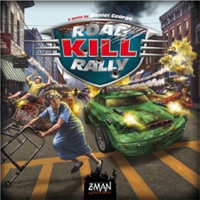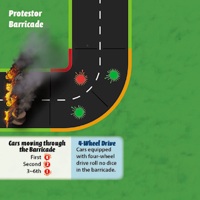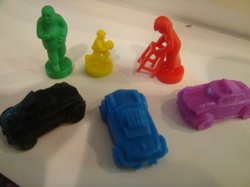by Andy Vetromile
 Road Kill Rally (2010)
Road Kill Rally (2010)
Published by Z-Man Games
Designed by Daniel George
Graphics and illustration by Karim Chakroun, Chris Quilliams, Edward Artinian, and Daisuke Shimizu
Contents: 20 Road Tiles, 68 Accessory Cards, 92 Rally Cards, 12 Skill Cards, 57 Shoot tokens, 3 Place tokens, 18 Wipe-out tokens, 40 Pedestrian miniatures, 6 Player Cars, 6 Player Tokens, 6 Dice, 6 Player Dashboards, 1 Rulebook
Playing time: 60-120 minutes
$60
Take the Paul Bartel/Roger Corman movie classic Death Race 2000,
file off the serial numbers, and add dice. The result is Road Kill
Rally, a brutal near-future racing game for two to six players in
which damage not done by careening about the roads at high speeds comes
from your opponents' lethal weapons fire. And if pedestrians get in the
way, well... they're worth some tasty points.
The object of the game is to amass the most points by the end of the race.
Me Go Vroom-Vroom
Players get a car, Accessories to kit it out, and a hand of Rally cards
(more on these in a moment). Everyone takes off from the starting line
on a game board built from randomly selected tiles, headed for a finish
line somewhere near the bottom of the deck. No one sees the next section
until someone reaches the end of the current one, so the fastest racer
is in front but others can plan their speed better – important if
the burning barricade segment blocks the road ahead. Speed goes up and
down in increments of 20 mph, which just translates to one space of
movement each. Travel is straightforward – advance a space and
shift left or right if you'd like.
 Straightaways aren't dangerous, but bends in the
road are rated by color. Compare the color of the turn to the car's
speed on the "dashboard" (the "character sheet" that tracks that
vehicle's activity) and, if there's a number shown, roll that many dice.
The special dice show blanks, splatters, and double splatters, with the
number of splatters being the damage done. Any die that shows a double
splatter is open-ended; the two symbols are added to the total and that
die is rolled again. Every Rally Card a player chooses to discard
before the roll eliminates one of these dice. If any are left to
roll, the result is how many Rally Cards are then discarded – each
driver must decide whether to play it safe now or chance it and pay the
piper afterward. If he hasn't enough cards to cover the damage, the car
wipes out, reducing his speed and tearing an Accessory Card off. He also
gets a wipe out counter that marks his misfortune.
Straightaways aren't dangerous, but bends in the
road are rated by color. Compare the color of the turn to the car's
speed on the "dashboard" (the "character sheet" that tracks that
vehicle's activity) and, if there's a number shown, roll that many dice.
The special dice show blanks, splatters, and double splatters, with the
number of splatters being the damage done. Any die that shows a double
splatter is open-ended; the two symbols are added to the total and that
die is rolled again. Every Rally Card a player chooses to discard
before the roll eliminates one of these dice. If any are left to
roll, the result is how many Rally Cards are then discarded – each
driver must decide whether to play it safe now or chance it and pay the
piper afterward. If he hasn't enough cards to cover the damage, the car
wipes out, reducing his speed and tearing an Accessory Card off. He also
gets a wipe out counter that marks his misfortune.
Various road tiles have different rules. Some have benefits, others have
hazards to overcome, and a few offer opportunities, but players won't be
content to let the streets do their dirty work for them. Accessories
represent weapons and other goodies attached to the car. These may be
flamethrowers, missiles, or guns; better drivers; or even candy to lure
pedestrian children to their doom. They have a range, effect, and damage
rating, and are "powered" by discarding Rally Cards as ammo. The combat
process is like a crash check, except the attacker gets to keep any
cards he forces his opponent to discard through damage. He also gets a
shoot token for a successful attack. Running over pedestrians is handled
much the same way except they're not usually armed. Usually. And of
course one cannot discount the possibility of simply ramming into each
other on a blocked and overcrowded raceway.
When the finish line appears, the race and the game are both almost
over. The first, second, and third players to cross it receive
(diminishing) rewards. Then everyone adds up their shoot tokens,
pedestrian kills, and winning placement points, while subtracting any
wipe out markers. The highest score wins.
Tools of the Trade
 Cool components make this a visual and tactile
pleasure. The cars feel a little slight, but they fit the spaces
perfectly. Even better are the pedestrian pieces – while the
adults pretty much just stand there, the little old ladies carry their
own walkers, and the kid markers look like they're ready to chase a
soccer ball across a busy street. (Apropos of nothing, the review copy
did come with a single adult figure whose base had not properly formed
during molding, but the 40 miniatures should be more than the game
requires anyway.) The road sections are good and thick, though the rules
text printed on each has to be a bit small lest it overshadow the rest
of the graphic design. The artwork ranges from painted portraits to
anime to comic-bookish. The dashboards easily contain everything a
driver needs and more. Not only is there space enough for his pedestrian
kills and the wipe out tokens he's saddled with, a turn and phase order
and other useful in-game references are printed in the corners. All
told, the bad news is limited to the speed indicator tokens (they have
only a hint of color to match them to their owners' dashboards, but
since they're otherwise identical...) and the rules (they succinctly
answer a lot of questions, but they can't speak to every
possibility). All this and a pile of cards for $60 blows the doors off.
Cool components make this a visual and tactile
pleasure. The cars feel a little slight, but they fit the spaces
perfectly. Even better are the pedestrian pieces – while the
adults pretty much just stand there, the little old ladies carry their
own walkers, and the kid markers look like they're ready to chase a
soccer ball across a busy street. (Apropos of nothing, the review copy
did come with a single adult figure whose base had not properly formed
during molding, but the 40 miniatures should be more than the game
requires anyway.) The road sections are good and thick, though the rules
text printed on each has to be a bit small lest it overshadow the rest
of the graphic design. The artwork ranges from painted portraits to
anime to comic-bookish. The dashboards easily contain everything a
driver needs and more. Not only is there space enough for his pedestrian
kills and the wipe out tokens he's saddled with, a turn and phase order
and other useful in-game references are printed in the corners. All
told, the bad news is limited to the speed indicator tokens (they have
only a hint of color to match them to their owners' dashboards, but
since they're otherwise identical...) and the rules (they succinctly
answer a lot of questions, but they can't speak to every
possibility). All this and a pile of cards for $60 blows the doors off.
The Winner's Circle (aka Conclusions)
There's more fun elements included with the game I haven't even hinted
at yet. The Rally Cards serve as ammo and damage, but each one also
sports an effect. Some offer other ways to rip at the enemy, such as an
orbital laser or a sniper in the crowd who's willing to help you regain
the lead. A few protect the user by dismissing damage done or rerolling
dice results. Still others improve your odds to hit, or permit the
driver a pitstop. Pitstops let you switch out Accessories (or replace
what was lost) as your position in the race changes. Additionally, every
driver gets a skill card that makes some part of the contest easier for
him, like reducing the dice in a crash check. True, this means there's
plenty going on, but the rhythm of the game makes recalling it all easy;
the rules are "one size fits all"; and the cards themselves are as
informative as the rulebook. The game can take the two hours the box
suggests, but players can control their schedule with fewer road tiles.
Road Kill Rally isn't a heavily strategic game. Attacks take
their toll (on both parties), but one racer won't determine the outcome
through clever actions or delaying tactics. Tiles like Shortcut
and Road Accident block or advance movement unpredictably,
ensuring that the finale is ever in doubt, no one's position is safe,
and even the hindmost are still in the running. Pure wargamers will find
this infuriating, but those whose egos come with a toggle switch will
see the whimsical fun, something that's necessary in a game that
unapologetically employs pedestrians as targets. (Seriously, there's no
sentimentality about it at all, so if the kids in the group need their
expectations managed, buyer (read: mom and dad) beware.) For the rest,
Road Kill Rally passes the test and the competition for the win.
Links:
| Other Z-Man Games reviews on OgreCave: |
|
|


 Road Kill Rally (2010)
Road Kill Rally (2010) Straightaways aren't dangerous, but bends in the
road are rated by color. Compare the color of the turn to the car's
speed on the "dashboard" (the "character sheet" that tracks that
vehicle's activity) and, if there's a number shown, roll that many dice.
The special dice show blanks, splatters, and double splatters, with the
number of splatters being the damage done. Any die that shows a double
splatter is open-ended; the two symbols are added to the total and that
die is rolled again. Every Rally Card a player chooses to discard
before the roll eliminates one of these dice. If any are left to
roll, the result is how many Rally Cards are then discarded – each
driver must decide whether to play it safe now or chance it and pay the
piper afterward. If he hasn't enough cards to cover the damage, the car
wipes out, reducing his speed and tearing an Accessory Card off. He also
gets a wipe out counter that marks his misfortune.
Straightaways aren't dangerous, but bends in the
road are rated by color. Compare the color of the turn to the car's
speed on the "dashboard" (the "character sheet" that tracks that
vehicle's activity) and, if there's a number shown, roll that many dice.
The special dice show blanks, splatters, and double splatters, with the
number of splatters being the damage done. Any die that shows a double
splatter is open-ended; the two symbols are added to the total and that
die is rolled again. Every Rally Card a player chooses to discard
before the roll eliminates one of these dice. If any are left to
roll, the result is how many Rally Cards are then discarded – each
driver must decide whether to play it safe now or chance it and pay the
piper afterward. If he hasn't enough cards to cover the damage, the car
wipes out, reducing his speed and tearing an Accessory Card off. He also
gets a wipe out counter that marks his misfortune.
 Cool components make this a visual and tactile
pleasure. The cars feel a little slight, but they fit the spaces
perfectly. Even better are the pedestrian pieces – while the
adults pretty much just stand there, the little old ladies carry their
own walkers, and the kid markers look like they're ready to chase a
soccer ball across a busy street. (Apropos of nothing, the review copy
did come with a single adult figure whose base had not properly formed
during molding, but the 40 miniatures should be more than the game
requires anyway.) The road sections are good and thick, though the rules
text printed on each has to be a bit small lest it overshadow the rest
of the graphic design. The artwork ranges from painted portraits to
anime to comic-bookish. The dashboards easily contain everything a
driver needs and more. Not only is there space enough for his pedestrian
kills and the wipe out tokens he's saddled with, a turn and phase order
and other useful in-game references are printed in the corners. All
told, the bad news is limited to the speed indicator tokens (they have
only a hint of color to match them to their owners' dashboards, but
since they're otherwise identical...) and the rules (they succinctly
answer a lot of questions, but they can't speak to every
possibility). All this and a pile of cards for $60 blows the doors off.
Cool components make this a visual and tactile
pleasure. The cars feel a little slight, but they fit the spaces
perfectly. Even better are the pedestrian pieces – while the
adults pretty much just stand there, the little old ladies carry their
own walkers, and the kid markers look like they're ready to chase a
soccer ball across a busy street. (Apropos of nothing, the review copy
did come with a single adult figure whose base had not properly formed
during molding, but the 40 miniatures should be more than the game
requires anyway.) The road sections are good and thick, though the rules
text printed on each has to be a bit small lest it overshadow the rest
of the graphic design. The artwork ranges from painted portraits to
anime to comic-bookish. The dashboards easily contain everything a
driver needs and more. Not only is there space enough for his pedestrian
kills and the wipe out tokens he's saddled with, a turn and phase order
and other useful in-game references are printed in the corners. All
told, the bad news is limited to the speed indicator tokens (they have
only a hint of color to match them to their owners' dashboards, but
since they're otherwise identical...) and the rules (they succinctly
answer a lot of questions, but they can't speak to every
possibility). All this and a pile of cards for $60 blows the doors off.